Deer ray, crammed in autumn
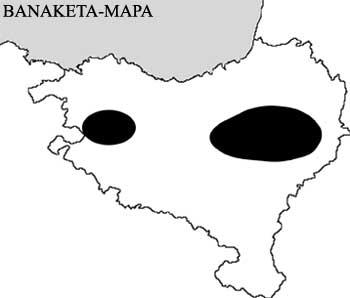
It is the last week of September in the forest of Irati. The green leaves of the hayos have begun to yellow and on the ground you can see numerous beech acorns. After the hot summer weather conditions, clouds are increasingly covering the sky and, at present, rain and cold are emphasizing the surrounding valleys and slopes. Suddenly, a deep and strong needle has broken the silence in the sunset zone; immediately another has responded to the first. In a few minutes, and responding to a hidden order, a terrible scandal has arisen within the dark protection of the beech. One needle is followed by the other, which is stronger, which is more terrible. The deer scratch has begun.
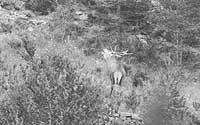
The deer is the largest of the wild artiodactyls present in the Basque Country. The weight of the animal ranges from 100 to 200 kg, being the height up to the cross between 100 and 140 cm. As in the rest of artifacts, the male is greater than the female. Although the fur is generally brown, it is variable throughout the year. If they are almost red in summer, in winter they have a more gray appearance, always with the back –high thighs– blackish.
On the other hand, and as in the roe deer, the butt is whitish. This posterior white scar has a defensive function on gregarious animals such as deer. And if any member of the group starts running if they see any danger, the rest of the group can quickly see the white scar jumping up and down, discovering the danger.

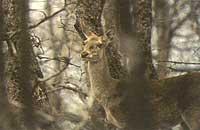
The most striking feature of deer anatomy is undoubtedly the excellent branch crown worn by males on the head. These branches are robust, branched bone structures that animals use as a terrifying weapon in zeal fights. However, and thanks to the peculiar shape of the branches, the use of these weapons does not usually give rise to excessively serious wounds in those fights, since the tips of the branches are arranged forming a large circle, so the branches get stuck in the fights, which usually are simple attempts of force.
The annual renewal of these branches is a characteristic of the group of the cervids. Between February and May, and due to the hormonal change in the dress of the male, the branches, drying the base, fall. Immediately and for a hundred days the new branches of the males develop. However, it is clear that the creation of new branches represents an important metabolic effort for the animal. In addition, the production of these structures requires obtaining raw materials, mainly calcium and phosphates, for what eats the fallen branches, while using reservoirs stacked in the bones.
Consequently, the size of the branches, and the number of them, depends on the age of the animal, and especially of the time: the deer of the first year develop branches of one end; those of the second year, and unless they have problems of food or health, will develop two branches of three extremes; finally, the adult deer can have 24 extremes.

The new branches are vascularized structures covered with skin similar to that of the balus and endowed with nerves, elongated sensitive “intense”. However, during the months of July or August, when these structures are fully developed, the animals begin to rub against branches and tree trunks, crumbling the branches and showing a healthy and painful inner bone. Witnesses of this work, in the jungles where deer, trunks, viaducts and young trees live are totally torn, these signs being one of the clearest manifestations of the presence of the animal. By September, and before the heat begins, the branches of the deer are again hard and sharp structures, terrifying weapons that will have to be used in the fight for the females.
As for the way of life, deer are gregarious mammals, and outside the aralar, females and young people live in their groups and adult males in their own. On the other hand, deer have a daytime activity; they feed mainly at dawn and dusk, and spend noon lying somewhere protected, quietly. As for food, deer are strict phytophagi, and especially herbivores. In order to improve the liserization of cellulose, they have a large stomach distributed in chambers, which after filling it with grass spend a lot of time reflecting on the food, passing the long stays of noon in this work. Although they prefer the grass, in spring they also feed the shoots of trees and bridges, and in winter they also consume the bark of the trees and the tips of the branches. In late summer and autumn, acorns, beech and chestnuts are the main ingredients of your diet. And in this time the animal has to accumulate the fats and other reserves necessary to spend the winter.
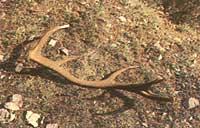
As mentioned above, the reproduction of the deer begins with zeal between September and October. At this time, flocks of sheep and females leave the protection of the jungle and concentrate on the pastures of the forest area, offering nature lovers a unique spectacle. The deep and powerful stripes of the males are truly exciting, and through them the shaped deer challenge each other to decide who owns the females. In this ritual all males with reproductive capacity participate, but the strongest, with the brightest branches, dominate the rest, young or weak, who in most cases must settle for mere presence. The older males take care that the females are wrapped and if a young male dares to approach them, they immediately evict him.
On the other hand, the real struggles occur among the main deer of the same period, thus establishing a strict sexual selection with the males. Therefore, only the brightest specimens will give genes to those of the next generation. However, it can happen that when two main males fight, taking advantage of the moment some young male has courage and covers some female. Thus, the selection established by the fights between the main males is added a random factor in order to the genetic evolution of the group.
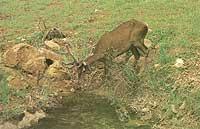
Breeding (usually only per female) is born in May or June. When the time comes, the female leaves the group and hides alone in the jungle to give birth to her baby. The birth, on the other hand, is very fast, around 10 minutes, and the newborn, painted with a white scar, rises immediately. After tracing, washing and deodorizing, and once given the chest, the mother hides between brambles or herbs and only occasionally approaches to give the breast and clean it to prevent a predatory enemy detecting him. When the child is 3 or 4 months old he starts eating grass and other solid foods, but there is still one year with his mother before joining the group.
Deer habitat has varied considerably in recent millennia mainly due to human activity. Although it is not possible to deny that the deer has always been an animal related to the jungle, and as indicated by the excellent admiration of the males, the closed forests are not the place of natural residence of this animal; excellent elements such as this would not be suitable to move comfortably in closed scrubs. On the other hand, the herbivore character of the animal also reinforces the idea. Because closed seals are not the best place to find grass. Before humans modified the environment in such an effective manner, deer could therefore inhabit areas where forests and grasslands normally coexisted: forest edges, river margins, peatland proximities, meadows or heath on forests, etc.
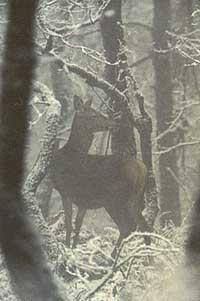
Later, when man began to dump jungles and create pastures, the deer habitat spread greatly, with an enormous expansion of the animal. However, as a result of the changes of the last century, humanization in most of the means of their own and the pressure of hunting have caused in all Europe a huge regression of deer, which currently only lives in hunting grounds and in protected places, always under human management.
In Euskal Herria the deer disappeared long ago, especially due to excessive pressure from hunting. However, in the 1950s they began to penetrate the mountains of Navarre and Alava, whose objective is fundamentally hunting. In 1957 I.CO.N.A. proceeded to the expulsion of several deer in the area of Gorbeia, after which they were also thrown by several individuals. Likewise, the Provincial Council and the State Forest Property Agency introduced deer in various Navarre locations: 11 specimens in Bertiz in 1956; 18 in Lantzen in 1957; and 26 specimens around Eugi in 1955-56 and 57. However, these deer had to overcome some drawbacks before forming a relatively stable population. On the one hand, the samples thrown came from Andalusia, which involved great difficulties to adapt to the local climate and, on the other, suffered bites from secret hunters.
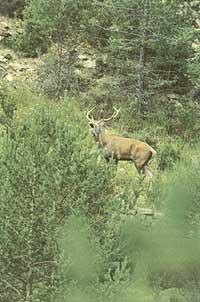
However, all these deer releases have led to the adaptation of two large populations in the Basque Country: one of them, located on the slopes of the Gorbeia, and whose number of deer could be around 500 specimens; another, inhabits the mountains of Navarra, in the area that goes from the mountains of Belate to Izaba, and which is composed of about 800 specimens. However, and although these populations can be considered important in quantitative terms, their character is totally artificial and their situation is not so clear (at least from a qualitative point of view). In a way, they are the “cattle” created so that hunters have to be captured and not the stable populations integrated into a balanced ecosystem.
In this sense, the degree of consanguinity within groups, demographic structures, the average size of animals and their level of health, etc. are characteristics to take into account in the event that in the future we look for the sustainability and full adaptation of the deer in Euskal Herria.
Technical information: DEER |
SPECIES
|





